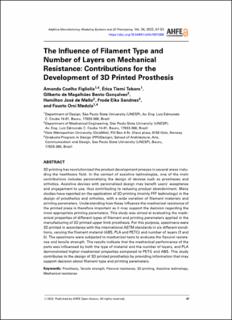| dc.contributor.author | Figliolia, Amanda Coelho | |
| dc.contributor.author | Tobaro, Érica Tiemi | |
| dc.contributor.author | Gonçalves, Gilberto de Magalhães Bento | |
| dc.contributor.author | de Mello, Hamilton José | |
| dc.contributor.author | Sandnes, Frode Eika | |
| dc.contributor.author | Medola, Fausto Orsi | |
| dc.date.accessioned | 2023-02-14T15:10:14Z | |
| dc.date.available | 2023-02-14T15:10:14Z | |
| dc.date.created | 2022-07-18T10:37:07Z | |
| dc.date.issued | 2022 | |
| dc.identifier.isbn | 978-1-958651-10-0 | |
| dc.identifier.uri | https://hdl.handle.net/11250/3050826 | |
| dc.description.abstract | 3D printing has revolutionized the product development process in several areas including the healthcare field. In the context of assistive technologies, one of the main contributions includes personalizing the design of devices such as prostheses and orthotics. Assistive devices with personalized design may benefit users’ acceptance and engagement to use, thus contributing to reducing product abandonment. Many studies have reported on the application of 3D printing (mainly FFF technology) in the design of prosthetics and orthotics, with a wide variation of filament materials and printing parameters. Understanding how these influence the mechanical resistance of the printed piece is therefore important as it may support the decision regarding the most appropriate printing parameters. This study was aimed at evaluating the mechanical properties of different types of filament and printing parameters applied in the manufacturing of 3D printed upper limb prosthesis. For this purpose, specimens were 3D printed in accordance with the international ASTM standards in six different conditions, varying the filament material (ABS, PLA and PETG) and number of layers (3 and 5). The specimens were subjected to mechanical tests to evaluate the flexural resistance and tensile strength. The results indicate that the mechanical performance of the parts was influenced by both the type of material and the number of layers, and PLA demonstrated higher mechanical properties compared to PETG and ABS. This study contributes to the design of 3D printed prosthetics by providing information that may support decision about filament type and printing parameters. | en_US |
| dc.language.iso | eng | en_US |
| dc.publisher | AHFE International | en_US |
| dc.relation.ispartof | Additive Manufacturing, Modeling Systems and 3D Prototyping. | |
| dc.relation.ispartofseries | Open Access Science in Human Factors Engineering and Human Centered Computing;Vol. 34 | |
| dc.rights | Navngivelse 4.0 Internasjonal | * |
| dc.rights.uri | http://creativecommons.org/licenses/by/4.0/deed.no | * |
| dc.subject | Prostheses | en_US |
| dc.subject | Tensile strength | en_US |
| dc.subject | Flexural resistance | en_US |
| dc.subject | 3D printing | en_US |
| dc.subject | Assistive technology | en_US |
| dc.subject | Mechanical resistance | en_US |
| dc.title | The Influence of Filament Type and Number of Layers on Mechanical Resistance: Contributions for the Development of 3D Printed Prosthesis | en_US |
| dc.type | Chapter | en_US |
| dc.type | Peer reviewed | en_US |
| dc.description.version | publishedVersion | en_US |
| dc.rights.holder | © 2022 | en_US |
| cristin.ispublished | true | |
| cristin.fulltext | original | |
| dc.identifier.cristin | 2038610 | |
| dc.source.pagenumber | 47-53 | en_US |

